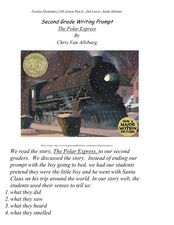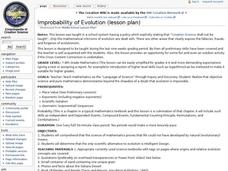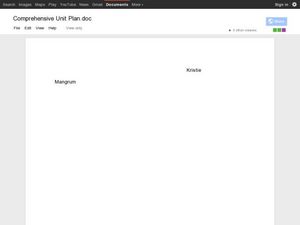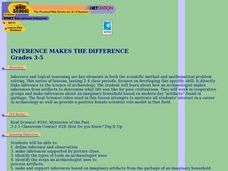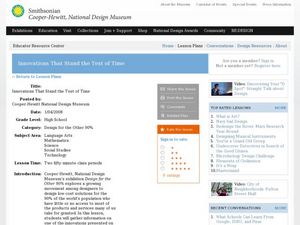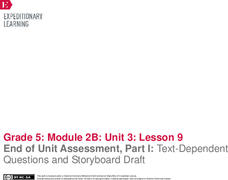Curated OER
Writing
Young scholars practice word processing skills while writing Haiku and diamonte poems. In this poetry computer lesson, students choose from a group of rainforest animals and write about their animal. Young scholars write a narrative...
Curated OER
The "Pick-Your-Favorite-Bat" Report
Students research one of the bats listed in the lesson plan. In this research lesson, students write a report using Microsoft Word and draw a picture that can be shared.
Curated OER
Sex Education
Seventh graders take a survey to determine their attitudes toward sexuality. In groups, they identify female and male reproductive organs and develop a list of secondary sex traits during puberty. They also discuss the stages of the...
Curated OER
Health Education: Stress Management
Third graders deal with stress. In this personal health lesson plan, 3rd graders define stress and demonstrate positive stress management strategies.
Curated OER
Planning a Road Trip!
Students generate plans for a fictitious road trip. In this time management lesson, students investigate the most effective way to travel the country arriving at specific cities. Students create their plans based on time and distance.
Curated OER
The Polar Express Writing Report
In this grade 2 writing prompt worksheet, students are give a writing prompt from the book The Polar Express about using their senses to write about going on a trip around the world with Santa Claus. Pages include a rubric and teacher...
Curated OER
A Visit to the Rain Forest
First graders preview "The Great Kapok Tree" by discussing the cover and the tree. They read the book and acknowledge the animals. They play a sequencing game in groups to identify the order the animals appeared in the book.
Curated OER
Narrative Writing
Students complete activities to learn narrative writing. In this narrative writing lesson plan students are given writing prompts in order to better understand how to write in a narrative format.
Curated OER
Improbability of Evolution
Students disprove evolution. In this science activity, students disprove evolution by attempting to prove that creation is the way it all began. They use the improbability that evolution could exist and expose its fallacies, frauds and...
Curated OER
Time Marches On
Students discover the times of Colonial America by creating a timeline. In this U.S. History instructional activity, students research a teacher-directed website about African Americans in early colonial times. Students utilize their...
Curated OER
Paul Revere's Ride
Third graders read and discuss the selection "Paul Revere's Ride" (included with the lesson). Students imagine they live in one of the villages that Paul Revere stopped. They are awakened by his knock on the door. Students write an essay...
Curated OER
Town Mouse/ Country Mouse
Students recognize the difference between the city and the country. In this City Mouse, Country Mouse lesson, students listen to a story and describe and map differences between the city and the country. Students understand that people...
Curated OER
The Life Cycle of the Mealworm
Fourth graders provide a habitat for live mealworms and observe their life cycle. In this animal life cycle and scientific inquiry lesson plan, 4th graders create a habitat for a live mealworm and observe and record related data as it...
Curated OER
Family Money Matters: Exploring the World of Economics
Students become familiar with vocabulary related to spending money. In this economics lesson, students participate in activities to learn about spending money and budgets.
Curated OER
Mass Measurement
Middle schoolers explore geometry by completing a physics activity on-line. In this mass measurement lesson, pupils define the terms mass, volume, and density and identify their relationship with each other. They complete an on-line...
Curated OER
Inference Makes the Difference
Students explore how archaeologists make inferences from artifacts to explore what life was like in the past. In this archaeology lesson, students work in groups and make inferences about an imaginary household based on modern day...
Curated OER
Innovations That Stand the Test of Time
Students create a class presentation that explains the value of an innovation to society. In this design innovation lesson, students discuss relationships among math, science, technology, and engineering, read a story about design...
Curated OER
Solving a Simple Maze
It is a-maze-ing how lost one can get. Teams reconstruct a simple maze and solve it. Participants create an algorithm that a robot would follow in order to solve the maze as well. The activity includes an extension directing pupils to...
EngageNY
End of Unit Assessment, Part 1: Text-Dependent Questions and Storyboard Draft: “You Can Do a Graphic Novel” Excerpt
Eyes on the finish line. Serving as the first part of the end of unit assessment, learners answer questions based on a text about how to write a graphic novel. Using what they've learned, they then create a storyboard about the invention...
Curated OER
The Three Little Pigs
First graders complete a fairy tales characteristics chart after listening to varoius fairy tales. Individually, they listen to three different versions of "The Three Little Pigs" and complete a separate chart comparing them as well....
Curated OER
Character Education-Honesty
First graders learn the importance of honesty as they practice problem solving, listening, and sequencing skills. The lesson uses the story, " Too Many Tamales."
Curated OER
We the People. . .
Students explore the United States Constitution. In this government lesson, students write newspaper editorials that reflect their opinions about Amendments.
Curated OER
Mapping Personal Narratives
Second graders write a personal narrative using webs they created and a story map worksheet. In this personal narrative lesson plan, 2nd graders make lists of ideas to write about and pick one to focus on.
Curated OER
The Dollar Cookie
Second graders recognize, count, and write money amounts using the cent symbol and identify equivalent amounts of money. In this money lesson plan, 2nd graders add money amounts using plastic coins and magnetic money.







